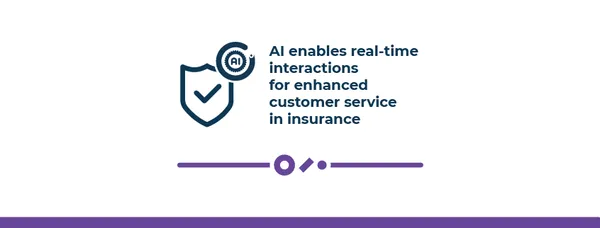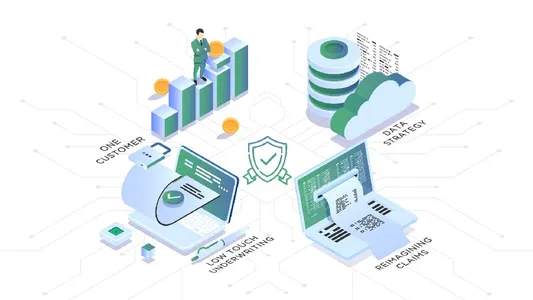Introduction
The insurance industry stands at the precipice of a transformative era with the integration of ML and AI. It raises an important question – How will these advanced technologies revolutionize the way insurers operate? From risk assessment and underwriting to claims management and customer engagement, machine learning and AI applications in the insurance sector hold immense potential. This article will explore the groundbreaking advancements and potential impact of machine learning and AI in the insurance landscape in the year ahead.
Table of Contents
Why ML and AI in Insurance?
Advanced technologies like machine learning, artificial intelligence, and deep learning have been the most widely accepted trends in the recent decade. They have been adopted by a majority of companies across all industries sheerly because of the operational benefits that companies can get into their value chain. The insurance industry is one such industry that has significantly benefitted from the incorporation of machine learning and artificial intelligence in its workflows. For starters, machine learning in insurance can help automate standard day-to-day functions and make the processes more efficient. Moreover, these technologies can help companies analyze and utilize tons of customer data to make better decisions and offer more profitable and personalized insurance policies to their customers. To learn more about how Machine Learning and AI impact Insurance companies, follow the article.
Recent Developments of AI in Insurance
- The Willis Towers Watson survey of life insurers highlighted that more than half the insurance companies used ML-driven predictive analytics for insurance underwriting.
- More than 76% of insurance professionals indicate that the innovation stakes have been the highest ever.
- More than 40% of CIOs have planned to increase their spending on AI use cases and pilot more automated insurance projects.
Clearly, there is a lot more for us to uncover about the applications of Machine Learning and AI in Insurance.
Top 5 Impacts of AI in Insurance

1. Automation
By giving insurers the ability to automate time-consuming and repetitive operations, increase operational effectiveness, and improve customer experience, ML can aid in the automation of the insurance sector. These algorithms can be used to automate operations like data entry, processing, and analysis, giving workers more time to concentrate on more challenging and complex jobs that call for human involvement.
2. Faster and Better Risk Assessment
Machine learning in insurance allows insurers to analyze massive amounts of data in real-time and spot patterns and linkages that traditional risk assessment methods would miss, which leads to faster and better risk assessment and risk management in the insurance industry. These machine learning algorithms can analyze data such as customer demographics, claims history, social media activity, and other relevant factors to create predictive models that can estimate the likelihood of future events and the associated risks.
3. Better Customer Lifetime Value (CLV) Prediction
Machine learning and AI for the insurance industry also benefit in better prediction of Customer Lifetime Value (CLV). ML algorithms can analyze customer demographics, purchase history, claims history, and other relevant factors in creating predictive models that can estimate a customer’s future value to the insurer. By predicting CLV, insurers can identify the most valuable customers and target them with personalized products and services that meet their needs.
4. Actuary Modeling
By increasing efficiency and accuracy in risk assessment, machine learning in insurance can benefit actuarial modeling. Actuaries forecast future occurrences and calculate their financial impact on insurance companies using mathematical and statistical models. By examining vast amounts of data to find patterns and links that conventional modeling techniques might miss, ML and AI can enhance these models.
5. Fraud Detection
With machine learning and AI in the insurance industry, many insurance companies detect patterns and potential anomalies in their customer data to indicate fraudulent activity. Moreover, ML algorithms can analyze social networks and other customer connections and identify potential fraud rings. On the other hand, AI-powered NLP (natural language processing) techniques can be implemented to analyze unstructured data like feedback, notes, etc., to find any other suspicious activity.
Use cases of AI in Insurance
- Efficiency Customer Support: Like other industries, the Insurance industry has a customer support vertical that caters to helping people throughout the insurance process. AI and ML can help make this process more efficient.
- Claim Fraud Detection and Prevention: AI and ML in insurance can help detect and prevent fraudulent claim attempts by analyzing historical claims data and finding patterns that suggest fraud.
- Insurance Pricing and Underwriting: AI and ML can help make better and more profitable insurance policies by analyzing market trends and forecasting future states.
- Accelerated Claims and Processing: These technologies facilitate faster processing of insurance claims by automating the central part of the process.
- Claims Reserve Optimization: Claim reserve is the money kept aside with an intent to pay in the future for incurred claims. AI and ML in insurance can help companies decide the appropriate amount of claims reserves based on company data.
- Personalized Recommendations: AI and ML can help with policy recommendations.
- Prediction of Customer Churn: These technologies can predict the likelihood of a customer not returning to avail of the product or service.
With these use cases, machine learning in insurance has impacted the industry in ways beyond imagination. It has enhanced general operations by automating and facilitating risk assessment and management, helping in actuary modeling, improving predictive analytics, and much more.
Top 15 Applications of Machine Learning in the Insurance Industry
There are countless applications of machine learning in insurance companies. ML algorithms can cater to almost all verticals, like customer onboarding, management, and retention, developing insurance data strategies, processing customer claims, implementing actionable life insurance plans, etc. Read on to learn about them in detail.
1. Streamline Customer Service

Customer service is an integral part of any business, especially the insurance business, as it aims to provide customers with financial assistance and guidance in an emergency. Whether general life insurance or healthcare insurance, customers expect to have a hassle-free experience in receiving their claims, inquiring about the plan, and understanding the process. Firms in insurance can automate these processes with the help of machine learning models and chatbots to provide services around the clock.
Moreover, an insurance company can use ML for predictive analytics to identify those most likely to make a claim in the future and plan accordingly to prevent losses. This can help insurance companies to cut costs and better customer satisfaction.
Application
Using an AI assistant dubbed Violet, Insurmi enables insurance businesses to provide quick and individualized client assistance. Thanks to NLP, machine learning, and UI ideas, Violet can adapt to conversations and manage customer support responsibilities for businesses.
2. Claims Processing

Claims processing is one of the most common applications of machine learning in insurance. ML helps in the process by automating the process of analyzing claim data. ML algorithms can analyze customer-provided data and compare it with the policy details to determine the claim’s validity. This can significantly reduce the time it takes to process insurance claims and enhance customer satisfaction. Additionally, these algorithms can recognize patterns in the data and map them to fraudulent claims, helping insurers to save money and reduce the risk of reputational damage via better decision-making.
Application
AI is used by CCC Intelligent Solutions to digitize and automate the whole claims process. Photographs taken at accident scenes are analyzed using AI and guidelines agreed upon by the insurance. Based on this information, CCC’s AI can determine the extent of the damage and promptly offer estimates.
3. Price Optimization

Price optimization refers to the analysis of consumer and market data to figure out the most optimal price point for any service or product. Machine learning and AI for the insurance industry also benefit the process of price optimization. ML algorithms can analyze data such as customer demographics, claims history, and policy details to identify which factors have the most significant impact on risk. This can help regulatory authorities to set prices for policyholders that accurately reflect the risk associated with each policy.
Application
The significant worldwide insurance provider AXA employs machine learning in a proof-of-concept to optimize pricing by accurately forecasting “large-loss” traffic accidents.
4. Insurance Underwriting

Insurance underwriting is the process of evaluating and assessing risks associated with insuring a person or an entity and determining the corresponding premium to be charged for the insurance/coverage. Factors like age, lifestyle, health and past claims help insurance agencies to compute the risk involved in insuring a business or an individual.
The insurance sector has embraced machine learning (ML) more recently to increase the effectiveness and operational efficiency of underwriting. Large volumes of data can be analyzed by ML algorithms, which can then spot trends that could be hidden from human underwriters. For instance, ML models can help insurers analyze data from wearables or other IoT (internet of things) devices to determine an individual’s health and risk of future medical claims.
Application
Using two AI-powered tools, SubmissionLink and ClauseLink, Bold Penguin enables insurance businesses to swiftly produce policies that stand out in the sector. SubmissionLink examines documents that carriers receive from authorities and identifies crucial information for underwriters. Meanwhile, ClauseLink analyses insurance provisions to assist providers in comparing their policies to those of rivals.
5. Insurance Products Recommendations

Providing product/policy recommendations is one of the most vital applications of machine learning in insurance. Primarily, ML algorithms can do so by analyzing large amounts of historical data related to customer behavior, demographics, and risk profiles. One common approach used in ML-based insurance product recommendations is collaborative filtering. The ML system can suggest life insurance to a customer if they share the same risk profile and purchasing history as another customer who just bought life insurance.
Application
For TLC insurance, INSHUR is a mobile-first method of buying car insurance. The INSHUR app, powered by AI, enables professional drivers to browse a range of estimates and get the coverage that best suits their needs.
6. Effective Intranet Search

Machine learning in insurance can significantly assist with effective intranet search by making the process more relevant for the employees seeking information within the company’s intranet. Company’s data scientists can utilize NLP and NLG algorithms to refine search queries and automatically generate summaries of intranet documents for other employees to study and formulate recommendations. Additionally, ML algorithms can be used to personalize search results for individual employees based on their search history and preferences. This helps in providing more relevant results.
Application
For intranet searches, Docusense is widely used by insurance companies. Insurance companies can automate the extraction of data fields and crucial values from any document (scanned and digital), including government identification documents, news feeds, bank statements, handwritten documents, and journals, with a well-trained AI system like Docusense.
7. Developing New Data Strategies

Another common application of machine learning in insurance is developing new data strategies by analyzing historical data to identify patterns and predict future outcomes, making better data-driven decisions. With up-to-date data strategies, insurance firms can come up with better customer segmentation based on their demographics and preferences, improving customer satisfaction and product recommendations and reducing customer churn.
Further, by aiding in fraud detection, risk management, and data visualization, the resulting insights can help insurance firms to develop more targeted data strategies.
Application
Lemonade, an InsurTech company, relies heavily on ML and AI-based big data analytics to power newer data strategies with collections of end-to-end insurance processes. It has helped the company undercut some of the finest insurance agencies in becoming a top-tier insurer for younger clients.
8. Customer Retention

Machine learning in insurance facilitates customer churn analysis, which lowers a company’s customer loss rate. Insurance companies can use ML algorithms to analyze historical customer data and identify patterns indicative of churn. These algorithms can also analyze customer behavior, provide insights, and suggest personalized campaigns to promote high-quality insurance policies. These insights can help insurance firms focus on customers at a higher risk of churning. This helps in moving towards having a stable revenue throughout the year.
Application
ZestFinance is an insurance firm that utilizes automated machine learning to utilize both conventional and non-conventional data, like credit scores, to make the process more efficient and hassle-free. Their ML is focused on contacting new customers and assisting the existing ones in ensuring customer retention.
9. Data Security

As companies are growing and working on massive amounts of data, it becomes necessary to ensure that this data is secure. This becomes even more important for businesses like the insurance business. The companies in these industries rely on customer data, preferences, health data, and customers’ lifetime value prediction. ML algorithms can be trained to detect anomalies or outliers in data that may indicate a security breach or suspicious activity. This can help insurance companies take proactive steps to mitigate these risks.
Application
MetLife is one instance of an insurance provider utilizing AI for data protection. Machine learning algorithms are used by MetLife’s AI-based security system to scan network traffic and spot irregularities that might be signs of a potential cyberattack. The system may also foresee and stop future attacks by identifying patterns and trends in cyber threats using previous data.
10. Lapse Management

In the context of insurance, the word “lapse management” refers to the practice of identifying and overseeing policies that run the risk of expiring or terminating as a result of unpaid premiums. It entails locating clients who are prone to lapse. Machine learning (ML) can play a significant role in insurance lapse management by enabling insurers to identify customers who are at risk of lapsing and take appropriate action to prevent it. Secondly, they can assist the companies in segmenting customers based on their lapse risk.
Application
Ant Financial, a Chinese finance super app, uses AI and ML algorithms to give “auto insurance points” to its customers. Based on these points, the system builds a comprehensive risk profile of the particular customer and predicts the chances of a policy lapse. It also takes other factors like lifestyle, age, vehicle, etc., into account during the process.
11. Training

Employee training is a vital aspect of building a reliable workforce in your organization. Machine learning in insurance can help in the scalable training of employees by creating personalized learning paths for each department and its employees. These plans focus on the skill level, job role, and learning styles of employees. ML can also provide automated feedback on employee performance, identifying areas where they are excelling and where they need improvement. This feedback is necessary for the regulatory authorities to keep their employees engaged and motivated throughout their tenure in the company.
Application
AI technologies are built into the Hi Marley Insurance Cloud to help train customer support representatives. For instance, Hi Marley’s platform provides real-time coaching and text translation to enhance interactions between salespeople and customers.
12. Next Best Offer Prediction

Next Best Offer (NBO) is a part of predictive analytics that involves identifying the most appropriate product or service to offer to a customer based on their needs and preferences. In the insurance domain, this refers to the practice of providing the most appropriate additional insurance products to the customers holding a current policy.
Machine learning in insurance can help skim through data sets and identify preferences that can be used to make targeted offers. For instance, ML and AI can analyze customer data to identify customers likely to be in the market for a new insurance policy, such as those who have recently purchased a home or started a new job.
Application
GetSafe is an InsurTech startup that guides clients using artificial intelligence to help them choose the best coverage. It employs AI to compile all pertinent data regarding a customer’s existing policy (if any) and other policies that may benefit them.
13. Insurance Software Testing

Testing software is one of the most prominent use cases and applications of machine learning in insurance companies. ML algorithms can prioritize test cases based on their likelihood of detecting a defect. Moreover, by analyzing historical testing data, they can be used to predict where defects are likely to occur and how they can be prevented. They can also detect unexpected behavior in running software systems and make recommendations on how it can be corrected.
Application
Allianz, a global insurance provider (ATS), created an AI-powered testing platform named Allianz Testing Services. ATS uses machine learning methods to evaluate enormous amounts of data and spot trends in software faults.
14. Virtual Assistants

Using and developing virtual assistants/chatbots is among common use cases of machine learning in insurance companies yet another technological advancement. Virtual assistants can use NLP algorithms to comprehend client inquiries, gather data, and deliver precise responses. With enormous datasets of discussions relating to insurance, machine learning models can be taught to gain accuracy over time. Furthermore, chatbots are a common use case of virtual assistants. Using ML, chatbots can understand customer queries, learn from previous interactions, and provide accurate responses.
Application
Maya, an AI chatbot created by an insurance firm called Lemonade, is intended to respond to client questions quickly and personally. When a consumer asks a question, Maya employs natural language processing (NLP) to understand, interpret, and react appropriately.
15. Property Assistant

A Property Assistant is a specific type of virtual assistant that insurance businesses utilize to offer personalized support and guidance to property owners for managing their property insurance. The assistant can either be a chatbot or a web-based platform that communicates with the property owners and offers guidance, suggestions, and support. These assistants use machine learning and AI models to carry out the tasks mentioned above, and help owners choose the most profitable insurance coverage based on their property.
Application
Trov is a firm that offers on-demand property insurance and handles insurance claims using AI. With the software, insurance may be started to cover all kinds of losses, damages, and thefts with the help of AI. Its AI property assistance also guides customers through the insurance process and helps them manage their valuables.
Conclusion
The insurance business may gain significantly from machine learning (ML) and artificial intelligence (AI), from enhancing customer experience and lowering costs to improving the accuracy of underwriting and claims processing. Insurance firms may use ML and AI to
- Make better decisions,
- Manage risks more efficiently,
- Expand their businesses by utilizing vast volumes of data,
- Analyze historical data,
- Offer better policies, etc.
If you wish to learn more about the capabilities of machine learning and artificial intelligence, you can head over to Analytics Vidhya (AV). AV is an excellent platform that houses numerous resources to help you learn about data science, software development, machine learning, artificial intelligence, and related areas. The platform offers:
- Video tutorials,
- Free courses,
- Community forums,
- Blogs.
With this vast collection, AV helps individuals, as well as organizations, build necessary skills, gain knowledge, and leverage their learning effectively.
Frequently Asked Questions
A. Artificial intelligence (AI) plays an important role in insurance by increasing operational efficiency, enhancing customer experience, and reducing risks by automating operations, analyzing data, and offering insightful analysis.
A. Benefits of using machine learning in auto insurance:
Improved risk assessment and management
Personalized pricing
Fraud detection
Faster claims processing
Better customer experience
A. There are some challenges that insurance companies face while adopting machine learning. Some of them are:
Organizational and infrastructural challenges
Financial aspects
Data quality
Ethical considerations
Interpretability by staff without ML familiarity
A. Machine learning is used by insurance companies to streamline procedures, enhance decision-making, and offer customers more specialized services. For tasks like risk assessment, fraud detection, and claim processing, they examine enormous volumes of big data, look for trends from multiple data sources, and generate predictions using machine learning algorithms.




